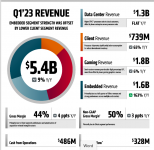Lisa Su mentioned that AMD intentionally underdelivered the volume to the channel and it's less than the market demand. In addition to the reason of reducing inventory in the channels, several other possibilities may explain why AMD chose to do that way:
1. Maintain the ASP (Average Selling Price) as much as possible under this downward market condition.
2. Not to damage AMD's gross margin too much under such bad market demand.
3. Prepare the potential surge in demand for the second half of the 2023.
Looking at AMD Q1 2023 result, its gross margin only dropped 4 ppt (GAAP) or 3 ppt (non-GAAP) Year over Year. It seems AMD did achieve the above #2 goal and generated $328 million free cash flow from operations after paying capital expenditure. For Q1 2023 Intel got negative $8,764 million free cash flow after capital expenditure, compare to positive $5,550 million in Q1 2022.
If Intel can not regain a meaningful and positive free cash flow from operations in the coming quarters, it will greatly limit its ability to compete.
OK, so now we're getting on the same page. AMD did lost market share, and a lot of it. But, and 1 and 2 on your list are similar, and probably have some truth to them. But then we have to ask, why was Intel able to make money in CCG, while AMD took a big loss. It's a bad situation there.
In a phrase "Real men have fabs". By the way, I'm guessing you might know that's from a former CEO of AMD.
Of course Lisa Su said they were lowering inventory in the channel, they had no choice, the channel made that decision. And Intel did the same thing. Both delivered fewer products than were consumed, that's not an AMD only situation. Dropping 65% is though

. Good grief.
And in clients, AMD lost money, Intel made money. So, let's not try to switch the discussion to something else. AMD LOST money. Intel MADE money in that segment. Of course, there's all sorts of sorcery behind those numbers (like where you allocate the R&D expenses, CAPEX, etc...), but it's not like AMD had a better quarter there. I love their console business though, and that's been a strength for AMD for a long time. And it saved them again.
Also, again a reminder, they had an extra week this quarter, and still had abysmal numbers.
And no, Intel doesn't have to generate free cash flow right away. The point is, to get the fabs built, the nodes on time, and deliver. Things will take care of themselves. Also, I have said this before, and Intel has as well, Intel front loads their expenses for the beginning quarters of the year, so that's not very important. What is important is that they are on time with products, gaining market share, and working through inventory downstream. Now if they lose money every quarter for a long time, yeah, but this is part of the long term investment strategy, and I think it's a good idea. Trying to maximize profits every quarter and being unwilling to suffer a few bad ones was a strategy previous management had (that swine Krzanich), and the company is still eating the bitter fruit from that.
I sure hope Intel goes after AMD's console business. What an asset that is. It's kept the company alive in the past, and it takes a lot of sting out of bad market conditions, because it's so reliable. And it served them well once again.



